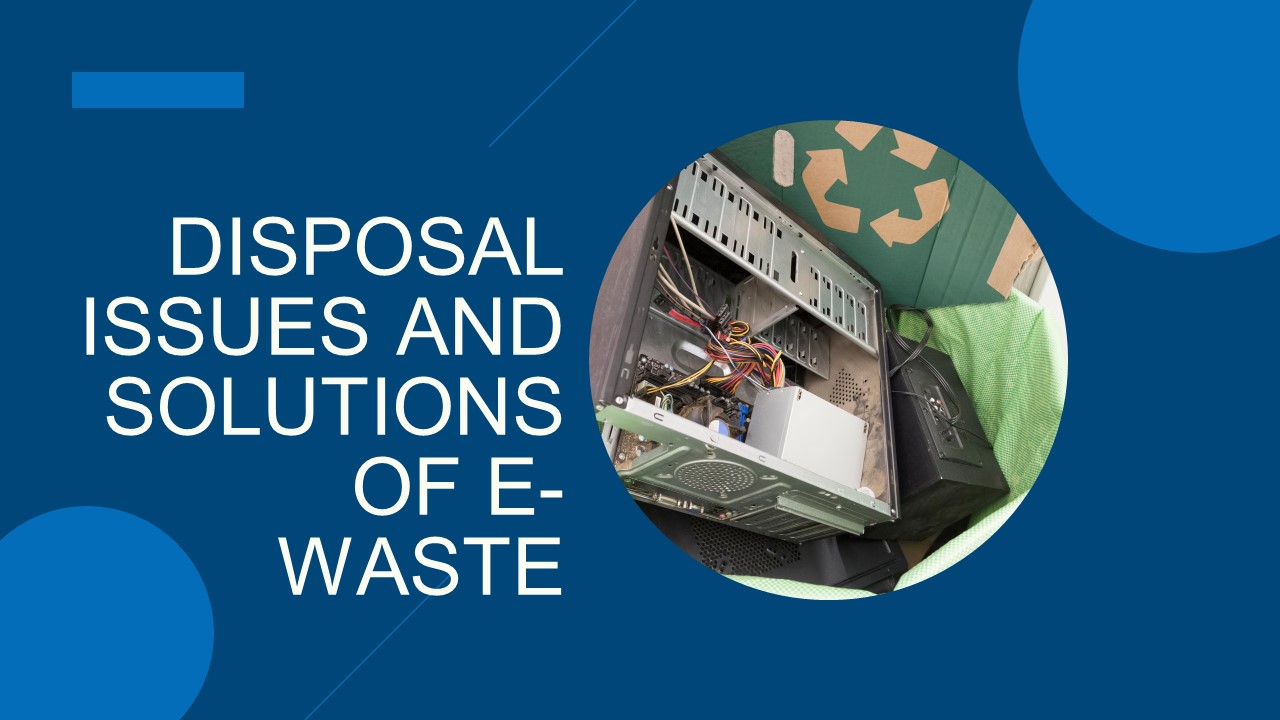Disposal Issues And Solutions Of E-Waste - PowerPoint PPT Presentation
Title:
Disposal Issues And Solutions Of E-Waste
Description:
The improper disposal of e-waste poses significant environmental and health risks, making it imperative to address disposal issues and implement sustainable solutions for e-waste management. – PowerPoint PPT presentation
Number of Views:1
Title: Disposal Issues And Solutions Of E-Waste
1
DISPOSAL ISSUES AND SOLUTIONS OF E-WASTE
2
The fast growth of technology and the resulting
rise in the disposal of electronic gadgets have
made electronic garbage, or e-waste, a major
global concern in recent decades. It is critical
to handle disposal concerns and put into place
sustainable solutions for managing e-waste since
inappropriate e-waste disposal poses serious
threats to the environment and human health.
computeritdisposals.co.uk
3
DISPOSAL ISSUES
- ENVIRONMENTAL POLLUTION
Hazardous materials including lead, mercury,
cadmium, and flame retardants can be found in
e-waste. These chemicals are released into the
environment by improper disposal methods
including landfilling or incineration, poisoning
the air, water, and soil.
computeritdisposals.co.uk
4
2. HEALTH HAZARDS
Cancer, neurological illnesses, respiratory
problems, and other major health issues can
result from exposure to harmful elements from
e-waste. These hazards are increased in many
developing nations by informal recycling
processes, which expose workers to hazardous
materials frequently without the necessary safety
gear.
computeritdisposals.co.uk
5
3.RESOURCE DEPLETION
Valuable materials found in electronic devices
include gold, silver, and rare earth metals. The
lack of effective recovery and reuse of these
resources due to inefficient disposal techniques
causes resource depletion and raises the demand
for raw materials.
computeritdisposals.co.uk
6
Sensitive company or personal data may leak as a
result of improper electronic device disposal.
Discarded gadgets could be a security issue if
proper data sanitisation procedures aren't
followed, which could result in identity theft or
business espionage.
4. DATA SECURITY RISKS
computeritdisposals.co.uk
7
SUSTAINABLE SOLUTIONS
8
- EXTENDED PRODUCER RESPONSIBILITY
Manufacturers must be accountable for the
complete lifecycle of their products, including
disposal, recycling, and collection, according to
EPR regulations. EPR encourages the creation of
effective recycling infrastructure and
incentivises designers to create products that
are recyclable by holding manufacturers
responsible.
computeritdisposals.co.uk
9
2. RECYCLING AND REFURBISHMENT
By putting in place extensive recycling
programmes, valuable resources can be recovered
from e-waste. Functional gadgets can have their
lifespan extended and the demand for new
production decreased by being refurbished and
resold. Cutting-edge methods like urban mining
minimise the negative effects of mining on the
environment by extracting resources from
electronic waste.
computeritdisposals.co.uk
10
3.LEGISLATION AND REGULATION
Through the adoption and application of rules,
governments play a critical role in the
management of e-waste. Laws should cover the
collecting of e-waste, recycling requirements,
and the outlawing of dangerous materials in
electronic devices. Controlling the transboundary
transport of hazardous waste, including e-waste,
is the goal of international accords such as the
Basel Convention.
computeritdisposals.co.uk
11
It is crucial to educate customers about the
negative effects that disposing of e-waste has on
the environment and human health. Education
initiatives can encourage ethical consumer
behaviour, such as the significance of selecting
environmentally friendly electronics and
appropriate recycling procedures. Promoting
programmes for device repair and reuse enables
users to prolong the life of their gadgets and
cut down on the production of e-waste.
4. PUBLIC AWARENESS AND EDUCATION
computeritdisposals.co.uk
12
CONCLUSION
Governments, manufacturers, consumers, and civil
society organisations must all work together to
address the disposal difficulties related to
e-waste. We can reduce the risks that e-waste
poses to the environment and public health while
advancing resource conservation and economic
development by enacting sustainable solutions.
computeritdisposals.co.uk
13
Contact Us
03330153501
info_at_computeritdisposals.co.uk
computeritdisposals.co.uk































